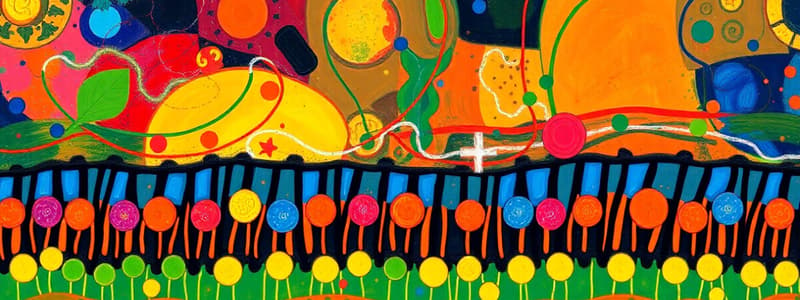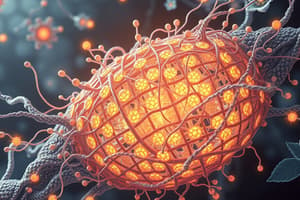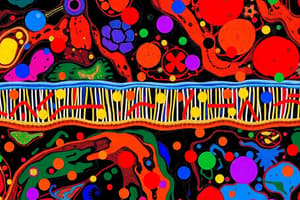Podcast
Questions and Answers
Which statement correctly describes the orientation of DNA strands?
Which statement correctly describes the orientation of DNA strands?
- Strands have neither polarity nor direction.
- One strand runs 3′–5′ while the other runs 5′–3′. (correct)
- Both strands run from 5′ to 3′ direction.
- Strands run parallel to each other in the same direction.
Which type of facilitated diffusion allows the movement of ions across the membrane through specific channels?
Which type of facilitated diffusion allows the movement of ions across the membrane through specific channels?
- Channel-mediated facilitated diffusion (correct)
- Simple diffusion
- Carrier-mediated facilitated diffusion
- Active transport
What is the result when the N-terminal ends of histones undergo reversible covalent modifications?
What is the result when the N-terminal ends of histones undergo reversible covalent modifications?
- They directly alter the nucleotide sequence of DNA.
- They erase all gene expression patterns permanently.
- They influence the binding affinity of histones to DNA. (correct)
- They cause the DNA to become a double helix.
Which of the following base pairings is correct according to the rules of complementary base pairing?
Which of the following base pairings is correct according to the rules of complementary base pairing?
What characterizes ligand-gated channels in channel-mediated facilitated diffusion?
What characterizes ligand-gated channels in channel-mediated facilitated diffusion?
Why is diffusion of ions through channels generally slower than diffusion through the lipid bilayer?
Why is diffusion of ions through channels generally slower than diffusion through the lipid bilayer?
During DNA replication, what is the primary role of DNA?
During DNA replication, what is the primary role of DNA?
Which statement accurately describes RNA's location and function?
Which statement accurately describes RNA's location and function?
Which substances typically utilize carrier-mediated facilitated diffusion?
Which substances typically utilize carrier-mediated facilitated diffusion?
What is the main characteristic of osmosis?
What is the main characteristic of osmosis?
In carrier-mediated facilitated diffusion, what occurs when the solute binds to the carrier protein?
In carrier-mediated facilitated diffusion, what occurs when the solute binds to the carrier protein?
What is the nature of the movement in facilitated diffusion?
What is the nature of the movement in facilitated diffusion?
Which type of channels remain closed until a specific event occurs?
Which type of channels remain closed until a specific event occurs?
What characterizes a competitive irreversible antagonist?
What characterizes a competitive irreversible antagonist?
How do non-competitive antagonists exert their effect?
How do non-competitive antagonists exert their effect?
Which modality of antagonism involves the formation of an inactive complex?
Which modality of antagonism involves the formation of an inactive complex?
What is the main difference between potency and efficacy in drug selection?
What is the main difference between potency and efficacy in drug selection?
What is the role of physiological antagonism?
What is the role of physiological antagonism?
Which type of antagonist has no affinity for the agonist's active site?
Which type of antagonist has no affinity for the agonist's active site?
What must occur for the effect of a competitive irreversible antagonist to cease?
What must occur for the effect of a competitive irreversible antagonist to cease?
In terms of drug safety, monitoring quantal dose-frequency curves is important for what reason?
In terms of drug safety, monitoring quantal dose-frequency curves is important for what reason?
How do non-competitive antagonists affect receptor activity?
How do non-competitive antagonists affect receptor activity?
Which antagonist type relies on a different pharmacological pathway to achieve its effect?
Which antagonist type relies on a different pharmacological pathway to achieve its effect?
What is the primary reason plasma has a different protein concentration than interstitial fluid?
What is the primary reason plasma has a different protein concentration than interstitial fluid?
What effect does hyponatremia have on extracellular fluid (ECF) volume?
What effect does hyponatremia have on extracellular fluid (ECF) volume?
Which of the following describes osmolality?
Which of the following describes osmolality?
How does osmotic pressure relate to the solute concentration in a solution?
How does osmotic pressure relate to the solute concentration in a solution?
What happens during osmosis when solute concentrations are equal on both sides of a membrane?
What happens during osmosis when solute concentrations are equal on both sides of a membrane?
Which of the following ions is primarily responsible for osmotic activity in extracellular fluid (ECF)?
Which of the following ions is primarily responsible for osmotic activity in extracellular fluid (ECF)?
Which statement about osmolarity is true?
Which statement about osmolarity is true?
What occurs when hypernatremia is present in the body?
What occurs when hypernatremia is present in the body?
What does the term 'particle bound to macromolecules' imply in relation to osmolality?
What does the term 'particle bound to macromolecules' imply in relation to osmolality?
In what situation would water movement across a membrane be prevented?
In what situation would water movement across a membrane be prevented?
What occurs during the G2 phase of the cell cycle?
What occurs during the G2 phase of the cell cycle?
What defines nucleic acids in terms of their structure?
What defines nucleic acids in terms of their structure?
In which phase do cells analyze DNA replication for possible errors?
In which phase do cells analyze DNA replication for possible errors?
What type of cells typically enter the G0 phase of the cell cycle?
What type of cells typically enter the G0 phase of the cell cycle?
Which statement about nucleotides is true?
Which statement about nucleotides is true?
What is one key function of nucleic acids in living organisms?
What is one key function of nucleic acids in living organisms?
Which of the following correctly describes how DNA differs from RNA?
Which of the following correctly describes how DNA differs from RNA?
What happens to cells that are highly differentiated after mitosis?
What happens to cells that are highly differentiated after mitosis?
What is the primary role of the G2 phase in the cell cycle?
What is the primary role of the G2 phase in the cell cycle?
Which of the following is a characteristic of the G0 phase?
Which of the following is a characteristic of the G0 phase?
What is the primary distinction between active and passive transport across the cell membrane?
What is the primary distinction between active and passive transport across the cell membrane?
In facilitated diffusion, what role do membrane channels play?
In facilitated diffusion, what role do membrane channels play?
Which of the following substances would most likely pass through the lipid bilayer via simple diffusion?
Which of the following substances would most likely pass through the lipid bilayer via simple diffusion?
What distinguishes channel-mediated facilitated diffusion from simple diffusion?
What distinguishes channel-mediated facilitated diffusion from simple diffusion?
What is a key characteristic of gated channels in channel-mediated facilitated diffusion?
What is a key characteristic of gated channels in channel-mediated facilitated diffusion?
Which scenario describes secondary active transport?
Which scenario describes secondary active transport?
What differentiates simple diffusion from facilitated diffusion?
What differentiates simple diffusion from facilitated diffusion?
In the context of passive transport, what does the term 'electrochemical gradient' refer to?
In the context of passive transport, what does the term 'electrochemical gradient' refer to?
What distinguishes voltage-gated channels from ligand-gated channels?
What distinguishes voltage-gated channels from ligand-gated channels?
Which substances typically require carrier-mediated facilitated diffusion to cross the plasma membrane?
Which substances typically require carrier-mediated facilitated diffusion to cross the plasma membrane?
How do molecules move during osmosis?
How do molecules move during osmosis?
What is a primary characteristic of active transport?
What is a primary characteristic of active transport?
Which processes are involved in the transport of water during osmosis?
Which processes are involved in the transport of water during osmosis?
What triggers the opening of voltage-gated channels?
What triggers the opening of voltage-gated channels?
Which of the following best describes the role of carrier proteins in facilitated diffusion?
Which of the following best describes the role of carrier proteins in facilitated diffusion?
What type of diffusion does osmosis fall under?
What type of diffusion does osmosis fall under?
What is the main characteristic of primary active transport?
What is the main characteristic of primary active transport?
Which process involves the movement of Na+ along its electrochemical gradient to drive the transport of another substance?
Which process involves the movement of Na+ along its electrochemical gradient to drive the transport of another substance?
Which of the following accurately describes the sodium-potassium pump?
Which of the following accurately describes the sodium-potassium pump?
What is the primary source of energy for secondary active transport?
What is the primary source of energy for secondary active transport?
What is the result of ATP hydrolysis in primary active transport?
What is the result of ATP hydrolysis in primary active transport?
In what way does active transport differ from passive transport?
In what way does active transport differ from passive transport?
Which of the following correctly describes the role of a carrier protein during secondary active transport?
Which of the following correctly describes the role of a carrier protein during secondary active transport?
What regulates the operation of the sodium-potassium pump at the cellular level?
What regulates the operation of the sodium-potassium pump at the cellular level?
Flashcards are hidden until you start studying
Study Notes
Facilitated Diffusion
- Channel-mediated facilitated diffusion: Solutes move down their concentration gradient through membrane channels, integral proteins that allow the passage of small, inorganic ions.
- Selective permeability: Channels are specific for the ions they allow to pass through.
- Leak channels: Remain open continuously.
- Gated channels: Only open when required; types include voltage-gated and ligand-gated.
- Voltage-gated channels: Open and close in response to changes in membrane potential.
- Ligand-gated channels: Open and close in response to binding of a specific molecule.
- Carrier-mediated facilitated diffusion: Larger solutes, such as glucose, fructose, and amino acids, move down their concentration gradient with the help of carrier proteins.
- Binding: The solute binds to the carrier protein, causing a conformational change.
- Transport: The conformational change moves the solute through the membrane.
Osmosis
- Movement of water: Osmosis is the net movement of water across a semipermeable membrane from a region of high water concentration to a region of low water concentration.
- Passive process: Osmosis does not require energy expenditure.
- Osmotic pressure: The pressure that needs to be applied to a solution to prevent the inward flow of water across a semipermeable membrane.
- Osmolality: The total concentration of osmotically active particles (solute) in a solution, expressed as osmoles per kilogram of water.
- Osmolarity: The total concentration of osmotically active particles (solute) in a solution, expressed as osmoles per liter of solution.
Osmosis and Tonicity
- Tonicity: Describes the osmotic pressure difference between two solutions.
- Isotonic: Two solutions have the same osmotic pressure.
- Hypertonic: A solution has a higher osmotic pressure than another solution.
- Hypotonic: A solution has a lower osmotic pressure than another solution.
- Water movement: In osmosis, water moves from a hypotonic solution to a hypertonic solution to achieve an isotonic state.
ECF (Extracellular Fluid) Composition
- Na+ concentration: Na+ is the dominant cation in the ECF, accounting for nearly all of the osmotic activity.
- ECF volume: Factors affecting Na+ concentration influence the ECF volume.
- Hyponatremia (low Na+): Leads to hypovolemia (low ECF volume).
- Hypernatremia (high Na+): Leads to hypervolemia (high ECF volume).
Competitive Antagonism
- Competitive reversible antagonist: Binds to the active site of a receptor, preventing agonist binding. The effect can be overcome by increasing the concentration of the agonist.
- Competitive irreversible antagonist: Forms a permanent covalent bond with the active site, making the receptor inactive. This effect is not reversible by increasing the agonist concentration.
Non-Competitive Antagonism (Allosteric Antagonism)
- Allosteric site: Antagonist binds to a site other than the active site, preventing agonist binding or activation.
- No impact on agonist binding: The antagonist does not compete directly with the agonist for the active site.
- Irreversible: This type of antagonism is not overcome by increasing the agonist concentration.
Other Modalities of Antagonism
- Physiological antagonism: Achieved by two agents acting on different receptors to produce opposing effects.
- Chemical antagonism: Occurs when two agents react chemically to form an inactive complex.
Studying That Suits You
Use AI to generate personalized quizzes and flashcards to suit your learning preferences.




